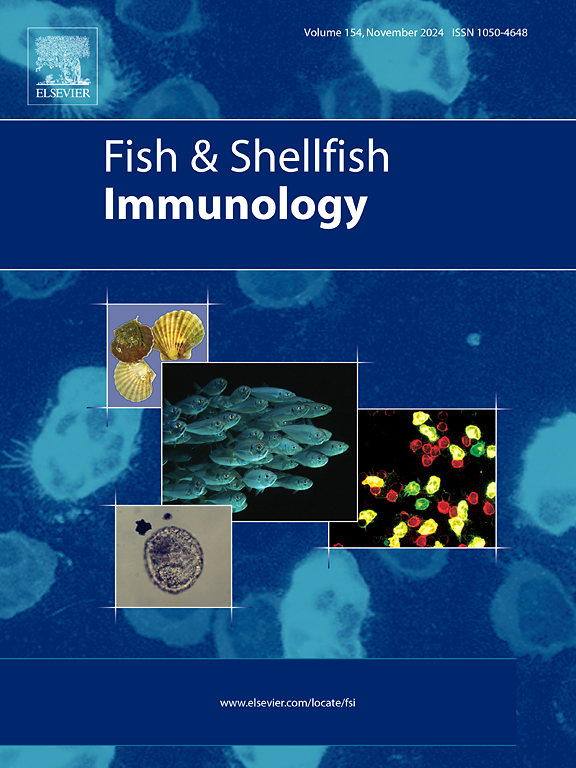鲤鱼肽聚糖识别蛋白2(CcPGRP2)可减轻嗜水气单胞菌引起的肠道菌群失调。
IF 4.1
2区 农林科学
Q1 FISHERIES
引用次数: 0
摘要
目的:肽聚糖识别蛋白 2 (PGRP2) 在调节鱼类的免疫防御方面发挥作用。我们之前的研究发现,肽聚糖识别蛋白 2 有助于维持鲤鱼肠道粘膜的完整性,并能在鲤鱼感染嗜水青虫时与细菌结合并凝集细菌。然而,它对微生物群结构的影响尚未明确。因此,有必要探讨 CcPGRP2 对鱼类肠道微生物群结构的影响:本研究给鲤鱼腹腔注射 CcPGRP2 蛋白,并利用高通量测序技术研究肠道微生物群结构的差异。首先,检测了对照组和处理组鲤鱼肠道微生物区系α和β多样性的变化,结果表明腹腔注射嗜水鲱鱼能显著降低鲤鱼肠道样本中微生物的α多样性(样本内)和β多样性(样本间),但 CcPGRP2 蛋白能缓解这种降低,无论是同时注射 CcPGRP2 蛋白和嗜水鲱鱼,还是间隔注射 CcPGRP2 蛋白和嗜水鲱鱼。随后,对不同处理下鲤鱼肠道微生物区系结构的不同分类水平进行了研究:结果:数据显示,给鲤鱼注射 CcPGRP2 可降低肠道病原气单胞菌的数量,而同时给鲤鱼注射 CcPGRP2 和嗜水气单胞菌时,缓解效果更好,这表明 CcPGRP2 具有抑制肠道菌群失调的功能。此外,功能预测表明了鲤鱼注射蚜蝇和 CcPGRP2 后可能出现的生理变化以及微生物对环境的影响。最后,细菌相互作用模式结果表明,注射嗜水青虫的组在聚类关系上偏离了对照组,而注射 CcPGRP2 可逆转嗜水青虫的影响,使微生物结构更接近对照组;同时注射嗜水青虫和 CcPGRP2 的效果优于间断注射:本研究的所有结果表明,CcPGRP2 可以缓解病原体感染下的内部菌群失调,这将为抗病育种提供基础。本文章由计算机程序翻译,如有差异,请以英文原文为准。
Common carp Peptidoglycan Gecognition Protein 2 (CcPGRP2) alleviates gut dysbiosis induced by Aeromonas hydrophila
Objectives
Peptidoglycan recognition protein 2 (PGRP2) plays a role in regulating immune defense in fish. Our previous studies found that CcPGRP2 helped maintain the integrity of the intestinal mucosa of carp and could bind and agglutinate bacteria when infected with A. hydrophila. However, its effect on the structure of the microbiota has not yet been clarified. Therefore, it is necessary to explore the effect of CcPGRP2 on the intestinal microbiota structure in fish.
Methods
In the present study, common carp were injected with CcPGRP2 protein intraperitoneally and high-throughput sequencing technology was used to study the difference in intestinal microbiota structure. Firstly, the variations in α- and β-diversity of the intestinal microbiota of common carp in control and treatment groups were tested, and the results indicated that intraperitoneal injection of A. hydrophila significantly reduced the microbial α-diversity (within-samples) and β-diversity (between-samples) in common carp gut samples, but CcPGRP2 protein could alleviate these reduction, no matter in the case of simultaneous injection of CcPGRP2 protein and A. hydrophila or a intermitted injection with first injection of CcPGRP2 and then A. hydrophila after 6 h. Subsequently, the intestinal microbiota structures of common carp on various taxonomic levels were interrogated under the treatments.
Results
The data revealed that the abundance of intestinal pathogen Aeromonas was reduced when CcPGRP2 was injected in the common carp, and the alleviation effect was better when CcPGRP2 was injected with A. hydrophila at the same time, implying the function of CcPGRP2 in inhibiting intestinal dysbiosis. Moreover, the functional prediction demonstrated the possible physiological shifts and the influences of microbes on the environment after the common carp is injected with A. hydrophila and CcPGRP2. Finally, the bacterial interaction patterns results showed that the groups injected with A. hydrophila were diverted away from the control group in terms of clustering relationship, while the injection of CcPGRP2 could reverse the effect of A. hydrophila and keep the microbial structure closer to that of the control group; meanwhile, the effect of simultaneous injection of A. hydrophila and CcPGRP2 was better than that of intermitted injections.
Conclusions
All the results in this study suggest that the CcPGRP2 could alleviate the internal dysbiosis under pathogen infection, which will provide a foundation for disease resistance breeding.
求助全文
通过发布文献求助,成功后即可免费获取论文全文。
去求助
来源期刊

Fish & shellfish immunology
农林科学-海洋与淡水生物学
CiteScore
7.50
自引率
19.10%
发文量
750
审稿时长
68 days
期刊介绍:
Fish and Shellfish Immunology rapidly publishes high-quality, peer-refereed contributions in the expanding fields of fish and shellfish immunology. It presents studies on the basic mechanisms of both the specific and non-specific defense systems, the cells, tissues, and humoral factors involved, their dependence on environmental and intrinsic factors, response to pathogens, response to vaccination, and applied studies on the development of specific vaccines for use in the aquaculture industry.
 求助内容:
求助内容: 应助结果提醒方式:
应助结果提醒方式:


